DSpace at VNU: Demographic Factors Affecting Organizational Commitment of Lecturers
Bạn đang xem bản rút gọn của tài liệu. Xem và tải ngay bản đầy đủ của tài liệu tại đây (107.74 KB, 10 trang )
VNU Journal of Science: Education Research, Vol. 31, No. 4 (2015) 16-25
Demographic Factors Affecting
Organizational Commitment of Lecturers
Võ Văn Việt*
Faculty of Foreign Language and Education Studies, Nông Lâm University,
Linh Trung Ward, Thủ Đức District, Hồ Chí Minh City, Vietnam
Received 02 February 2015
Revised 26 October 2015; Accepted 22 December 2015
Abstract: Many studies have confirmed the organizational commitment is an important factor
deciding the success or failure of the organization. However, how to commit employees with the
organization is a challenge for many agencies and organizations. This study was conducted to
determine the demographic factors that affect organizational commitment of university lecturers.
The study was conducted at a university with a convenient sampling method so the results are not
generalized to all university lecterers. The results showed that there were low correlation
between years of work and continuance commitment; between gender and affective
commitment; between highest degree earned with normative commitment. There was a
moderate correlation between position hold and affective commitment. There was a low
negative correlation between age and normative commitment. The correlation between other
demographic variables with OC was negligible.
Keywords: Organizational commitment, demographic factor, faculty member.
1. Introduction *
important for an organization to study OC of
employees. Since most of the works done
dealing with organizational commitment
provides an abundance of information regarding
the area of business and industry but a very
limited amount of information in the area of
higher education. A growing need exists to
understand the impact of organizational
commitment upon higher education. Because
educational institutions are different from
commercial organizations, they have to develop
a different management strategy. As stated by
Wittenauer (1980) "With the ever increasing
pressure on higher education for accountability,
the advent of consumerism, legalism and the
Organizational commitment (OC) of an
employee is a topic that has received
considerable attention by researchers and
managers. One way to increase productivity in
many organizations is to increase employee
commitment. A better understanding of
organizational commitment and factors
associated with them helps managers guide
employees' activities in a desired direction. The
turnover rate can be reduced with a higher level
of organizational commitment. Therefore, it is
_______
*
Tel.: 84-908849631
Email:
16
V.V. Việt / VNU Journal of Science: Education Research, Vol. 31, No. 4 (2015) 16-25
tight economic situation. it is necessary that
higher education administration be aware of
those factors which help recruit and retain
faculty who are of the highest caliber relative to
teaching, research and public service".
Furthermore, because prior research in the
literature
suggests
the
possibility that
demographic factors may differentially relate to
the OC in diffirent setting, so it is necessary to
exploy the effect of demographic factors to OC of
faculty member in higher educational institution.
17
the questionnaire, organizational commitment
questions, was adapted from the Three
Component
Model
(TCM)
Employee
Commitment Survey which was developed by
Meyer, Allen (1991) to measure respondents’
commitment to their organization. There are
three subscales which are affective, normative
and continuance commitment. Part II, the sociodemographic profile questions, was developed
by the researcher. Several Likert-type items was
used to determine the level of OC. Indicators on
the Likert-Type Scale range from 1 ( Strongly
disagree) to 7 (Strongly agree).
2. Methodology
2.1. Research design
The main objective of this study was to
understand demographic factors affecting
organizational commitment of faculty members.
Therefore, the research methodology used in
the study was basically quantitative.
Specifically, a descriptive-correlational survey
research design was applied. The survey was
conducted at the Nong Lam University, located
in Ho Chi Minh City, Vietnam. The population
of the study comprises of faculty members from
all departments. Since only one organization
was surveyed, the researcher’s place of
employment, generalizability from this
convenience sample to employees outside of the
target population is not recommended because
of the lack of statistical random sampling in
various organizations.
2.2. Method of gathering data
Data were collected by using a
questionnaire. The questionnaire consisted of
two independent sections including sociodemographic
profile
questions
and
organizational commitment questions. Part I of
2.3. Validity - three component model (TCM)
employee commitment survey
Allen and Mayer (1996) evaluated the
construct validity of the three commitment scale
through a narrative review of research in which
they have been used.
The evidence for
construct validity was provided by factor
analysis: (a) relations among the commitment
measures and related measures; (b) the factor
structure of the continuance commitment; and
(c) the stability of the factor structures across
time. The patterns of correlation between the
commitment measures and other variables also
indicated that the validity was established. The
measurement was adopted by over 40 employee
samples, representing more than 16,000
employees from a wide variety of organizations
and occupations. (Allen & Meyer, 1996).
For the present study, twenty four items
were selected to measure three dimensions of
organizational commitment. There were fifteen
items that have significant high loading scores,
nine items were deleted from further analysis
since they show low loading. Results are shown
in table 1.
18
V.V. Việt / VNU Journal of Science: Education Research, Vol. 31, No. 4 (2015) 16-25
Table 1: Result of factor analysis for organizational commitment inventory
Items
AC3. I really feel as if this organization's problems are my own.
AC2. I enjoy discussing my organization with people outside it.
AC1. I would be very happy to spend the rest of my career with this organization.
AC7. This organization has a great deal of personal meaning for me.
AC6. I do not feel 'emotionally attached' to this organization. (R)
AC5. I do not feel like 'part of the family' at my organization. (R)
AC8. I do not feel a strong sense of belonging to my organization. (R)
CC7. One of the few serious consequences of leaving this organization would be the
scarcity of available alternatives.
CC6. I feel that I have too few options to consider leaving this organization.
CC8. One of the major reasons I continue to work for this organization is that leaving
would require considerable personal sacrifice -another organization may not match the
overall benefits I have here.
CC3. Too much in my life would be disrupted if I decided I wanted to leave my
organization now.
CC2. It would be very hard for me to leave my organization right now, even if I wanted to.
NC2_I do not believe that a person must always be loyal to his or her organization. (R)
NC3_Jumping from organization to organization does not seem at all unethical to me. (R)
NC8_I do not think that wanting to be a 'company man' or 'company woman' is sensible
anymore. (R)
Component
1
2
3
.743
.720
.696
.693
.573
.340
.499
.743
.701
.697
.654
.420
.643
.613
.457
Extraction Method: Principal Component Analysis.
Rotation Method: Varimax with Kaiser Normalization.
a. Rotation converged in 6 iterations.
y
2.4. Reliability
Allen and Mayer (1996) evaluated the
reliability of the three commitment scale. The
median reliability across 40 studies,
representing more than 16,000 employees from
a wide variety of organizations and
occupations, were .85, .79, .73 for affective,
continuance, and normative commitment
respectively and with a few exceptions, all
reliability estimates exceeds .70. Both
exploratory and confirmatory factor analysis
validated the TCM and factors were stable over
time (Allen & Meyer, 1996). Meyer et al.
(2002) conducted a meta-analysis of the
antecedents, correlates and consequences of the
Three-Component Model of OC, the finding
suggested that the model might indeed be
applicable in other countries and cultures
outside North America. However, care should
be taken in attempting to apply the model and
measures outside North America. In this
research, the Cronbach’s coefficient alphas for
subsection organizational commitment were as
follow:
affective commitment (r=.779),
continuance commitment (r=.654), normative
commitment (.66), the adopted instrument was
concluded to be reliable.
Since the purpose of this study was not to
make individual predictions based on the
organizational scale, but rather to investigate
broad trends and relationship between certain
variables, the instruments were considered to be
psychometrically acceptable.
V.V. Việt / VNU Journal of Science: Education Research, Vol. 31, No. 4 (2015) 16-25
2.5. Statistical treatment
Data were analyzed using the Statistical
Package for the Social Sciences (SPSS®
Version 18.0 for Windows). There are eight
items in part I of the questionnaire, the
commitment scales, have been worded such that
strong agreement actually reflects a lower level
of commitment. These are referred to as
“reverse-keyed” items (identified by “R” after
the statement in the questionnaire). These items
are included to encourage respondents to think
about each statement carefully rather than
mindlessly adapting a pattern of agreeing or
disagreeing with the statements. All reversekeyed statements were recoded using
‘Transform’ function as following: 1 = 7, 2 =
6, 3=5, 4=4. 5=3, 6=2, 7=1. This is done so that
all the negatively worded statements’ score
were reversed and transformed to reflect them
in positive manner to enable correct relationship
analysis can be carried out. For scoring
purposes, scores on, and averages were
computed based only on items relevant to the
specific scale. Affective, normative and
continuance commitment scores were obtained by
averaging participants’ scores on each subscale of
part II of the questionnaire. Scores on 15 items
were averaged to yield a summary score reflecting
total organizational commitment.
Data from the first part of the questionnaire
has ordinal value and were assumed to be
interval. For part II, the continuous variables
age and years of work were grouped into 5-year
age categories. The variables such as age, years
of work, percentage of time devoting to job
activities were treated as interval data. Highest
earned degree, position (power status) were
treated as ordinal data. Gender variable were
coded as nominal data. If an item in the
questionnaire was left blank by a respondent or
19
if a response was marked more than once, that
answer was treated and coded as missing data
(=9) and not included in the analysis.
3. Reviewed of related literature
3.1. Organizational commitment: definitions
and its antecedents
Many definitions exist in the literature for
organizational commitment. Organizational
commitment refers to degree to which an
employee identifies himself with the
organizational goals and wishes to maintain
membership in the organization. Organizational
commitment does not have a generally
acceptable definition among authors. However,
according to Mathis and Jackson (2000)
organizational commitment can be defined as
“the degree to which employees believe in and
accept organizational goals and desire to remain
with the organization.”. Organizational
commitment, as defined by Mowday, others
(1979), is ‘‘the relative strength of an
individual’s
identification
with
and
involvement in a particular organization’’ (p.
226). They mentioned three characteristics of
organizational commitment: a strong belief in
and acceptance of the organization’s goals and
values (identification), a willingness to invest
effort on behalf of the organization (involvement),
and a strong intent or desire to remain with the
organization (loyalty). These characteristics imply
that the members of the organization wish to be
active players in the organization, have an impact
on what is going on in it, feel that they have high
status within it, and are ready to contribute
beyond what is expected of them (Bogler R. and
Somech A., 2004).
O'Reilly and Chatman (1986) supported the
notion that OC should be seen as
20
V.V. Việt / VNU Journal of Science: Education Research, Vol. 31, No. 4 (2015) 16-25
multidimensional construct. They defined
organizational commitment as a psychological
attachment to the organization predicted by
three independent constructs, those of
compliance, identification and internalization.
Compliance is defined as involvement for the
extrinsic rewards. Identification is involvement
with the organization because of the desire for
affiliation and is an important mechanism in the
developing
process
of
psychological
attachment. Internalization is involvement
based on the individual's acceptance of the
organization's values. Absenting or resigning
from the job versus job satisfaction is a
predictor of organizational commitment. The
concept has been very popular in the recent
times. Organizational commitment depends
upon job enrichment factor and degree to which
the workers enjoy autonomy and freedom of
action while performing.
The most popular multidimensional
approach to OC is that of Meyer and his
colleagues. Meyer and Allen (1991) stated that
organizational commitment is "a psychological
state that a) characterizes the employee's
relationships with the organization, and b) has
implications for the decision to continue
membership in the organization" (p. 67).
Allen & Meyer (1984) initially viewed
organizational commitment as two-dimensional
namely, affective and continuance. Allen &
Meyer (1990, p 6) defined normative
commitment as “the employee’s feelings of
obligation to remain with the organization”.
Consequently, the concept of organizational
commitment isdescribed as a tri-dimensional
concept, those are: affective, continuance and
normative.
They
defined:
“Affective
Commitment refers to the employee’s
emotional attachment to, identification with,
and involvement with the organization.
Employees with a strong affective commitment
continue employment with the organization
because they want to do so. Continuance
Commitment refers to an awareness of the costs
associated with leaving the organization.
Employees whose primary link to the
organization is based on continuance
commitment remain because they need to do so.
Finally, Normative Commitment reflects a feeling
of obligation to continue employment. Employees
with a high level of normative commitment feel
that they ought to remain with the organization.”
(Meyer & Allen (1991) p. 67)
In other word, employees with a strong
affective commitment remain with the
organization because they want to; those with
strong continuance commitment remain because
they need to; and those with strong normative
commitment remain because they feel they
ought to do so (Meyer & Allen, 1991).
Common to all of the three types of
commitment is the view that commitment is a
psychological state that characterizes the
employee's relationship with the organization,
and commitment has implication for the
decision to continue or discontinue membership
in the organization. Employees with a strong
affective commitment remain with an
organization because they want to, those with a
strong continuance commitment remain because
they have to, and those with a strong normative
commitment remain because they feel they
ought to (Meyer, Allen and Smith, 1993).
Meyer & Allen (1991) have used affective,
continuance, and normative commitment to
capture the multidimensional nature of
organizational commitment. However, affective
commitment is considered a more effective
measurement of organizational commitment.
Meyer & Allen (1997) explaining that employees
with strong affective commitment would be
V.V. Việt / VNU Journal of Science: Education Research, Vol. 31, No. 4 (2015) 16-25
motivated to higher levels of performance and
make more meaningful contributions than
employees who expressed continuance or
normative commitment.
Using the three major components, Irving
and others (1997) investigated the relationship
between affective, continuance, and normative
commitment and the outcome measures of job
satisfaction. Total participants for the study
included 232 employees. Results revealed that
job satisfaction was positively related to both
affective and normative commitment. However,
job satisfaction was negatively related to
continuance commitment. All three types of
commitment were negatively related to turnover
intentions, with continuance commitment
having the strongest negative relationship.
Cohen & Kirchmeyer (1995) undertook a study
titled “A multidimensional approach to the
relations between organizational commitment
and nonwork participation” to investigate the
relationship between affective, continuance, and
normative commitment and the non-work
measure of resource enrichment. They found
the positive relationships between resource
enrichment and both affective and normative
commitment. However, the relationship
between continuance commitment and resource
enrichment was negative. In effect, employees
who were staying with the organization because
they wanted to or felt they ought to, indicated
higher involvement and enjoyment with work
activities. Whereas, employees who were
staying with the organization because they felt
they needed to indicated less involvement and
dissatisfaction with work activities (Cohen &
Kirchmeyer, 1995).
There are hundreds of studies have been
conducted to identify factors involved in the
development of organizational commitment.
Studies conducted into the relationship between
personal or demographic variables and
organizational commitment revealed that there
is a degree of relationship between personal or
demographic variables like gender, age, marital
status, and years of working experience or
tenure, educational qualification, status, race and
so on with organizational commitment. Baron and
Greenberg (1990) proved that older employees
are seem to have higher level of organizational
commitment than other age groups. Meyer and
Allen (1997) described that organizational
commitment is associated with gender.
4. Result and discussion
4.1. Sample demographic characteristics. Age
of respondents
Table 2: Age of respondents
Age
Below 30 years old
From 31 to 35
From 36 to 40
From 41 to 45
From 46 to 50
From 51 to 55
Above 56
Total
Frequency
59
41
25
15
14
21
28
203
21
Percent
29.1
20.2
12.3
7.4
6.9
10.3
13.8
100.0
Cumulative Percent
29.1
49.3
61.6
69.0
75.9
86.2
100.0
Note: Mean=39.23, Median=36.0, Mode=29. Range=39, Standard deviation=11.36
22
V.V. Việt / VNU Journal of Science: Education Research, Vol. 31, No. 4 (2015) 16-25
4.2. Gender of respondents
4.3. Education level of respondents
Respondents were asked to state their
gender. The analysis of the demographic
variables indicates that there are more male
than female respondents. The gender
distribution was 66% (n=134) male and 34%
(n=69) female. Table 4.2 reports the gender of
faculty members participated in the research.
Respondents were asked to indicate the
highest level of education they have achieved.
More than half of respondents, Fifty-five
percent (n=112), have master degree as their
highest education level, 21.7% (n=44) held a
doctorate degree, while 23.2% (n=47) held a
bachelor’s degree. The table 4 describes the
education levels of the respondents:
Table 3: Gender of respondents
Gender
Male
Female
Total
Frequency
134
69
203
Percent
66.0
34.0
100.0
Table 4: Highest educational level
Doctorate
Master’s
Bachelor’s
Total
Frequency
44
112
47
203
Percent
21.7
55.2
23.2
100.0
Valid Percent
21.7
55.2
23.2
100.0
Cumulative Percent
21.7
76.8
100.0
l
4.4. Years of work
The questionnaire also inquired about the
years of work of each faculty member. Forty
seven respondents (23.2%) have been working
in the faculty from 1 to 5 years; forty
respondents (19.7%) from 6 to 10 years; Thirty
six respondents (17.7%) from 11 to 15 years;
thirty respondents (14.8%) over 30 years;
twenty respondents (9.9%) from 21 to 25 years;
ninety respondents (9.4%) from 16 to 20 years;
and eleven respondents (5.4%) from 26 to 30
years. The mean number of years working with
the University was approximately fifteen (15)
years. The range was 1 to 38 years, and a standard
deviation of 10.89. Years of work of faculty
members are presented in the table 5 below:
Table 5: Years of work
From 1 to 5 years
From 6 to 10 years
From 11 to 15 years
From 16 to 20 years
From 21 to 25 years
From 26 to 30 years
Over 30 years
Total
Frequency
47
40
36
19
20
11
30
203
Percent
23.2
19.7
17.7
9.4
9.9
5.4
14.8
100.0
Cumulative Percent
23.2
42.9
60.6
70.0
79.8
85.2
100.0
Note: Mean=14.6, Median=12.0, Mode=1. Rang=37, Standard deviation=10.89
V.V. Việt / VNU Journal of Science: Education Research, Vol. 31, No. 4 (2015) 16-25
23
4.5. Position held by respondents
Table 6: Position held by respondents
Position
Rector/Vice rector
Dean/Vice dean and the like
Department head
Lecturer
Total
Frequency
1
35
28
139
203
Percent
.5
17.2
13.8
68.5
100.0
Cumulative Percent
.5
17.7
31.5
100.0
s
Approximately 18% of the respondents hold
the rank of vice dean or higher and nearly 14%
is department heads. The majority (68.5%) of
the respondents were lecturers.
4.6. The correlation of demographic variables
with the organizational commitment
Faculty members’ affective, normative and
continuance commitment scores were obtained
by averaging participants’ scores on each
subscale. Particularly, level of affective
commitment was calculated by summing
responses from 7 items: AC1, AC2, AC3,AC5,
AC6, AC7, AC8 of part II of the questionnaire
then dividing by 7. The level of normative
commitment was calculated by summing
responses from 3 items: NC2, NC3, NC8 of part
II of the questionnaire then dividing by 3. The
level of continuance commitment was calculated
by summing responses from 5 items: CC2, CC3,
CC6, CC7, CC8 of part II of the questionnaire
then dividing by 5. And scores on 15 items were
averaged to yield a summary score reflecting total
organizational commitment.
Table 7: Correlation Matrix for organizational commitment and demographic variables
Age
Position held
Educational level
Years of works
Gender
Affective
Commitment
Pearson Correlation .121
Sig. (2-tailed)
.085
N
203
Pearson Correlation .354**
Sig. (2-tailed)
.000
N
203
Pearson Correlation .024
Sig. (2-tailed)
.735
N
203
Pearson Correlation .125
Sig. (2-tailed)
.075
N
203
Correlation
-.142*
Coefficient
Sig. (2-tailed)
.043
N
203
*. Correlation is significant at the 0.05 level (2-tailed).
**. Correlation is significant at the 0.01 level (2-tailed).
F
Normative
Commitment
-.139*
.047
203
.038
.589
203
.165*
.019
203
-.110
.117
203
.008
Continuance
Commitment
.184**
.009
203
.087
.215
203
.096
.173
203
.180**
.010
203
-.100
.912
203
.157
203
24
V.V. Việt / VNU Journal of Science: Education Research, Vol. 31, No. 4 (2015) 16-25
Table 7 indicates that the relationship
between the respondents’ demographic
characteristics and organizational commitment.
There were low correlation between years of
work and continuance commitment (r=.18,
p<0.01); between gender and affective
commitment (r=.142, p<0.05), this finding is
not in line with the study of Ellemer, Gilder,
and Heuvel (1998), they found that gender was
not clearly related to three forms of
commitment; between highest degree earned
with normative commitment (r=.165, p<0.05);
between age and continuance commitment
(r=.184, p<0.01). There was a low negative
correlation between age and normative
commitment (r=-.139, p<0.05). There was a
moderate correlation between position hold and
affective commitment. The correlation between
other demographic variables with OC was
negligible (0.01-0.09).
5. Conclusion
The findings in this study partially contradict
with other studies in the literature about the
correlation between demographical characteristics
with OC. Luthans, McCaul, & Dodd (1985) and
Allen and Meyer (1993), they found the positive
relationship between age and affective
commitment. Age has been regarded as a positive
predictor of OC because as the employees’ age
increase employment options generally decrease,
making their job more attractive.
Organizational commitment of employees
have always been important issues and should be
taken into consideration for managers. However,
there is no universal set of practice can be applied
as every organization and its employees are
unique and thus throughoutly study before
implementing any practices is crucial.
References
[1] Wittenauer, Martha A., Job Satisfaction and
Faculty Motivation, Unpublished doctoral
dissertation. Indiana University, Indianapolis,
1980.
[2] Meyer, J. & Allen, N., A three-component
conceptualization of organizational commitment,
Human Resource Management Review, 1(1)
(1991) 61.
[3] Allen, N. J. & Meyer, J. P., Affective,
continuance and normative commitment to the
organization: Anexamination of construct
validity, Journal of Vocational Behavior, 49
(1996) 252.
[4] Meyer J. P., Stanley D. J., Herscovitch L and
Topolnytsky L., “Affective, Continuance and
Normative Commitment to the Organization: A
Meta-analysis of Antecedents, Correlates, and
Consequences”, Journal of Vocational Behavior,
Vol. 61(2002) 20.
[5] Mathis, R.L., & Jackson, J.H., Human resource
management. 9th ed. Cincinnati, Ohio: South
Western College Publishing, 2000.
[6] Mowday, R. R., Steers, R. M., and Porter, L. W.,
The
measurement
of
organizational
commitment, Journal of Vocational Behavior, 14
(1979) 224.
[7] Bogler, R., & Somech, A., Organizational
citizenship behavior in school: How does it
relate
to
participation
in
decision-
[8]
[9]
[10]
[11]
making? Journal of Educational Administration,
43(5) (2005) 420.
O'Reilly, C, and Chatman, J., Organizational
commitment and psychological attachment: The
effects of compliance, identification, and
internalization on pro-social behavior. Journal of
Applied Psychology, 71(3) (1986) 492.
Meyer, J. P., Allen, N. J. and Smith, C. A.,
Commitment to organizations and occupations:
Extension and test of a three-component
conceptualization,
Journal
of
Applied
Psychology, 78(4) (1993) 538.
Meyer J and Allen N., Commitment in the
Workplace: Theory, Research, and Application,
Sage Publications, 1997.
Irving, P., Coleman, D., and Cooper, C., Further
assessments of a three-component model of
occupational commitment: Generalizability and
differences across occupations, Journal of
Applied Psychology, 82(3) (1997) 444.
V.V. Việt / VNU Journal of Science: Education Research, Vol. 31, No. 4 (2015) 16-25
[12] Cohen, A.
and
Kirchmeyer,
C.,
A
multidimensional approach to the relation
between organizational commitment and nonwork participation, Journal of Vocational
Behavior, 46 (1995) 189.
[13] Baron, R.A. and J. Greenberg., Behavior in
Organization: Understanding and Managing the
Human Side of Work, Third Edition, Toronto:
Allyn and Bacon, 1990.
25
[14] Ellemers, N. De Gilder, D. And vanden Heuvel,
H., Career-oriented versus team-oriented
commitment and behavior at work, Journal of
applied Psychology, 83 (1998) 717.
[15] Luthans, F., McCaul, H. S., and Dodd, N. G.,
Organizational commitment: A comparison of
American, Japanese and Korean employees,
The Academy of Management Journal, 28(1)
(1985) 213.
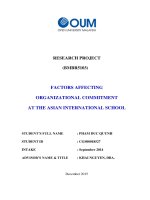
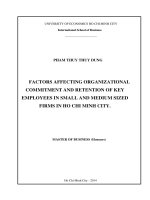
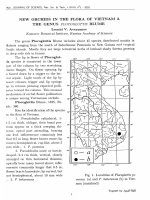
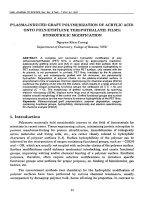

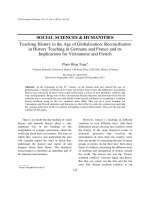
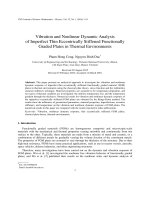
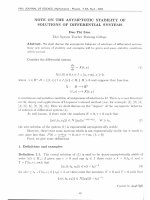
![DSpace at VNU: Corrigendum to ‘‘Nonlinear dynamic response of imperfect eccentrically stiffened FGM double curved shallow shells on elastic foundation’’ [Compos. Struct. 99 (2013) 88–96]](https://media.store123doc.com/images/document/2017_12/14/medium_vrh1513028470.jpg)
